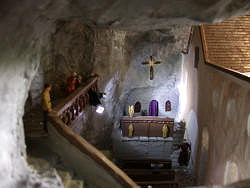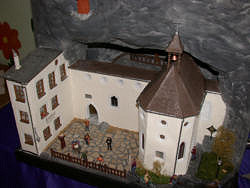Klösterl
Useful Information



| Location: |
Klösterlweg 1, 93309 Kelheim.
Near Kehlheim in the Danube gorge, left bank of the Danube. Kehlheim, car park P5 (Wöhrdplatz) at the boat landing stage. 15-minute walk upstream in the direction of "Lange Wand/Weltenburger Enge". Alternative hiking trail from the Befreiungshalle to the Danube. (48.909635, 11.851395) |
| Open: |
Currently closed. [2024] |
| Fee: |
free. [2024] |
| Classification: |
 Cave Church Cave Church
|
| Light: |
 Electric Light Electric Light
|
| Dimension: | |
| Guided tours: | self guided |
| Photography: | allowed |
| Accessibility: | yes |
| Bibliography: | |
| Address: |
Einsiedelei Klösterl, Hedwig & Hermann Riemann, Klösterlweg 1, 93309 Kelheim, Tel: +49-9441-1745151, Tel: +49-1515-6023366.
E-mail: |
| As far as we know this information was accurate when it was published (see years in brackets), but may have changed since then. Please check rates and details directly with the companies in question if you need more recent info. |
|
History
| 1289 | Hermits settle in the caves. |
| 02-FEB-1454 | Duke Albrecht grants brother Anton permission to live in the hermitage with his brothers and to take wood from the ducal forests. |
| 05-JAN-1455 | Duke Albrecht grants the brothers land around the Bruderloch, which is confirmed by Emperor Frederick. |
| 05-JUL-1459 | Confirmation by Pope Pius II. |
| 1459 | Brother Anton cedes his property to the Franciscans in Würzburg. |
| 09-MAY-1472 | Pope Sirtus IV orders in a breve the surrender of the monastery "Bruderloch" to the Tertiaries. |
| 05-JUL-1472 | The monastery is handed over to Frater Wilibaldus by Prior Johannes. |
| 1603 | Cave church built. |
| 1803 | Klösterl falls to the state through secularisation and is given to university professor, judge and notary, Ritter von Wels, who transforms it into a much-visited excursion site and summer resort. |
| 1840 | Designated as a natural monument. |
| 1938 | nature reserve. |
| 2001 | purchased and restored by the Riemann family. |
| 2002 | awarded the official seal of quality "Bavaria’s most beautiful geotopes" by the Bavarian Ministry of the Environment. |
| 2008 | reopened as a restaurant for tourists. |
| 2006 | Inclusion of the in the list of 77 distinguished National Geotopes of Germany. |
| 13-FEB-2020 | designated as a National Natural Monument. |
| 2020 | closed due to the Corona pandemic. |
Description




The Klösterl (Bavarian diminutive for monastery) is located on the left bank of the Danube between the "Weltenburger Enge" and Kelheim. On shores the Danube, which is already quite wide here, there are large limestone rocks; the Danube has cut an 80 m deep canyon into the White Jurassic (Malm, Upper Jurassic) here and formed a canyon. It is known as the Donaudurchbruch (Danube Breakthrough) at Weltenburg or Weltenburger Enge (Weltenburg Narrows), named after the large Weltenburg Monastery on the right side of the Danube at the entrance to the breakthrough. The whole area was designated as a natural monument as early as 1840 under Ludwig I. In 1938, the nature reserve was established, which today is also designated as a geotope and national natural monument. In fact, however, the term Danube Breakthrough is somewhat misleading. The valley was deepened about 80,000 years ago by a tributary of the Altmühl-Danube, while the Danube flowed further north in what is now the Altmühl Valley. During the Riß cold period, the Danube shifted its bed southwards into what is now the Danube valley. The Danube has since deepened the valley by a further 15 m.
The Klösterl is a group of caves and abris (shelters), which are partly a result of karstification and were cut open when the valley was incised. But the river has also created half-caves in the rock walls, which are thus not karst caves but erosional caves. Two caves, the Bruderloch and the Goldofen, were inhabited by hermits early on, and the remains of the hermitages can still be visited today. According to some sources, friars of the Tertians settled in the shelters as early as 1289. The Franciscans were one of the four great mendicant orders of the Middle Ages, so they had very similar values to the hermits. The Third Order (Tertians) was an umbrella term for communities consisting mainly of lay people who joined one of the major orders in the Catholic Church, in this case the Franciscans. It is also called the tertiary monasteries or the regulated 3rd Order of St Francis (Tertius Ordo Regularis Sancti Francisci=TOR).
In 1454, the Brother Antonius de Septem Castris built a simple hermitage and chapel. The chapel was dedicated to Saint Nicholas, the patron saint of boatmen. Several forest brothers of the Tertians joined him. He had the support of the dukes Albrecht III and Ludwig the Rich. He received various inheritances, which financed the construction of the buildings. Duke Albrecht granted Brother Anton permission to live in the hermitage with his brothers and to take wood from the ducal forests. This is therefore considered the founding date of the Franciscan monastery. In 1455, he also granted the friars land around the Bruderloch, which was confirmed by Emperor Frederick. On 5th July 1459 the monastery also received confirmation from Pope Pius II. However, Brother Anton had to cede the monastery to the Franciscans in Würzburg; the reasons do not seem to have been handed down, nor the exact date. Either in 1457 or 1459, Brother Anton tied up his bundle, walked to Vienna, bought a horse and armour to march against the Turks, and was attacked, robbed and beaten to death by robbers.
The Franciscans soon relinquished the monastery, and on 9 May 1472 Pope Sirtus IV issued a decree ordering the "Bruderloch" monastery to be handed back to the Tertiaries. On 5 July 1472, the monastery was handed over to Brother Wilibaldus by Prior Johannes. Later the Tertiaries handed the monastery "Bruderloch" back to the Franciscans, with whom it remained until secularisation. The monastery was dissolved by secularisation and the properties fell to the state in 1803, which sold them. The new owner, university professor, judge and notary, Ritter von Wels, transformed it into a much-visited Ausflugsgaststätte, a restaurant which was popular with day-trippers and summer visitors. It is still privately owned today.
In 1603, a cave church was built as part of the monastery. Its special feature is that it actually uses the cave as its roof and rear wall, only the wall facing the Danube is brick. This makes it one of the few genuine cave churches in Central Europe. However, the valuable frescoes in the cave church have been severely damaged by the dampness in the church and the frequent floods of the Danube. The terracotta figure of St. Nicholas in a niche in the rock above the church is also famous. The buildings also contain a museum showing the history of the monastery through the Celts, Romans, early Middle Ages to modern times.
The cave church is a popular excursion destination, respectively visited by tourists, cyclists and hikers as part of the Donaudurchbruch (Danube breakthrough). In the buildings in front of the church there is a popular restaurant and beer garden. Unfortunately, this is often closed. Some time ago, the entire complex was so badly damaged after a flood that it was closed for years for renovation. The damage was so extensive that at first it was not at all certain whether the funds for renovation could be raised. The current owners bought the Klösterl in 2001 and renovated it with private funds, and it reopened in 2008. However, the town of Kehlheim has repeatedly come up with nonsensical chicanes that have led to temporary closures on several occasions. One of these was the requirement to pipe the waste water underground to Kehlheim at its own expense, which would have required a 2.4 kilometre long waste water pipe, a completely unaffordable construction. This is particularly incomprehensible because the town of Kehlheim benefits greatly from this popular attraction. The restaurant was also completely closed during the corona pandemic. The Klösterl is still closed, with the owners citing health reasons.
The pictures on the top right do not show the church itself, but an extremely detailed model owned by the Forschungsgruppe Höhle und Karst Franken (FHKF).
 Search DuckDuckGo for "Klösterl"
Search DuckDuckGo for "Klösterl" Google Earth Placemark
Google Earth Placemark OpenStreetMap
OpenStreetMap Franziskanerkloster - Einsiedelei Klösterl
Franziskanerkloster - Einsiedelei Klösterl  (visited: 19-AUG-2022)
(visited: 19-AUG-2022) Index
Index Topics
Topics Hierarchical
Hierarchical Countries
Countries Maps
Maps